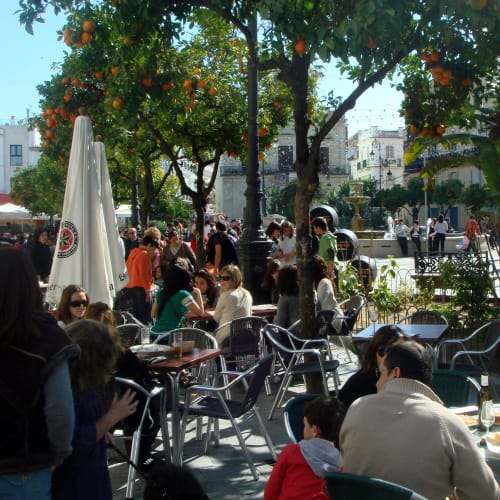Columbus the Connoisseur
October 2004




I am in the midst of reading an absorbing book named “Rivers of Gold -- the Emergence of the Spanish Empire from Columbus to Magellan” by Hugh Thomas. The deftly written volume is filled with countless fascinating details -- including a series of them that confirms my conviction that Spaniards carry the appreciation of food to the highest levels:
When Columbus returned from his first voyage, he visited King Fernando and Queen Isabel at the Monastery of Guadalupe to show his great treasures. Before them he presented not only gold and silver (of which he had very little), but also he proudly displayed exotic living plants and foods that he had gathered in the New World. From what I understand, these treasures of food were what most excited the Court.

The peppers Columbus brought were planted in nearby fields and the strain eventually evolved into the famous smoked paprika (pimentón de la Vera) -- now a central seasoning of Spanish chorizos, lomo and various stews. Soon thereafter Hernán Cortéz brought chocolate and tomatoes from the Aztecs, and the Pizarro brothers brought potatoes from the Incas of Peru.
On the other side of the coin, when the explorers embarked from Sevilla to explore the New World, goats and sheep were aboard as well in order to feed the passengers and crew. On the Santa María, seagoing fare was not confined to hardtack and grog. As early as his second voyage, Columbus had on board 30 rustic Ibérico pigs to serve as breeding stock in New Spain, (so that the settlers would not be deprived of "pata negra"!) In the next two years the herd grew to 300. Believe it or not, descendants of these pigs may now reside here in Williamsburg, Virginia!!
When my son Tim and I visited Spain a couple of weeks ago, we could see that not much has changed during the ensuing 500 years - fine food is very important to the Spanish. Blessed as they are with an abundance of food products, Spaniards literally feast on the bounty of their land. In fact, many Spaniards hardly ever eat at home - they would rather meet friends and family at neighborhood cafés where they eat extraordinary foods as daily fare: truly fresh shellfish, the best of hams and wild game.
As Tim and I settled in to enjoy lunch at an outdoor café in a seaside town, our waiter approached us displaying a tray laden with shellfish. At one end of the oval platter was a huge live lobster waving his claws at us. At his feet were little gambas from Huelva, bright red shrimp from El Puerto de Santa María, cigalas, langostinos, navajas (razor clams) and more. He said proudly, "Pick what you would like. We will weigh it and prepare it for you -- the price is only $100/kilo." Next to us a normal family of six was relishing three platters of shellfish -- they must have consumed a $500 meal! But what a lovely afternoon it was -- to be sitting in the sun along the shore, savoring some of the best seafood in the world.

The next day we took a country road north of Córdoba, weaving through the pastureland dotted with gnarled oak trees whose acorns are the favorite diet of the Ibérico pigs. We were on our way to visit a cooperative of farmers, some of whom were dedicated to producing jamón ibérico, arguably the finest ham in the world, for export to America.
As we toured the facilities with our friend Abel, we realized that this was no ordinary meat processing plant. Here was a group of people who viewed the production of their jamones as a work of art. No expense had been spared in their quest to produce the best. They even record the genealogy of each pure-bred breeding sow and her offspring. They monitor every detail of the lives of the piglets to be sure that they are treated well, with ample room to roam and enough acorns in their diet. This creates the ideal conditions to produce the coveted "pata negra" - a meat beautifully marbled and richly nutty in flavor. As we talked with some of the artisan workers we could sense their pride.
Later, the officers of the cooperative graciously invited us to join them for lunch. On the table before us was an extraordinary selection of meat that was parallel in quality to the seafood prepared for us the previous day. This time there were large platters of jamón ibérico and lomo (loin of pork) as well as unique cuts of Ibérico pork. As if that were not sufficient, also on the table was a plate of tasty lamb, as well as the finest beef steak I have ever tasted. It was an Atkins paradise -- and a gourmet's dream.
Without a doubt, the people of Spain enjoy their food and spare no effort to prepare the best - whether I am referring to the settlers of the Americas 600 years ago, or our neighbors today. They achieve a quality of life which is enviable. This is why it is so satisfying to our family to travel the byways of Spain befriending artisans who honor their culinary traditions. Their products enable us in the New World to participate - if only in a small way - in the quality of Spain.
During this month in which we celebrate the Spanish national holiday Dia de Hispanidad, and our national holiday Columbus Day, I am grateful for the interchange of cultures which makes all our lives richer.
My best to you and your family,
Don

